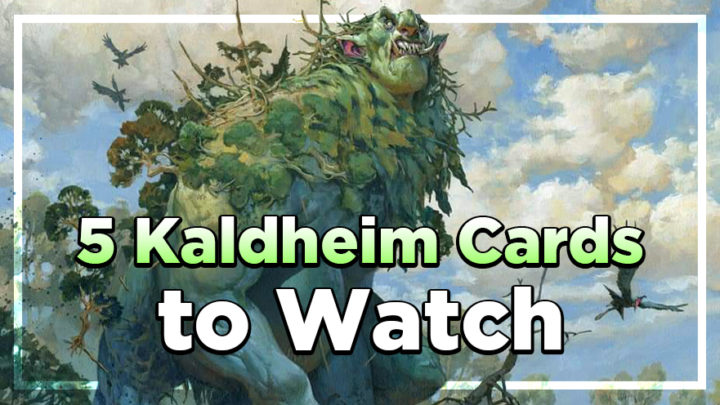It’s that time of year again! Less than a month ago, we were getting holiday presents, and now we have even more gifts to look forward to. Kaldheim is shaping up to be one of the more interesting sets we have seen in a while, full of vikings, monsters, and exciting Magic cards! Here are five cards we’ve seen so far that I’ll be keeping my eye on for Standard.
Niko Aris
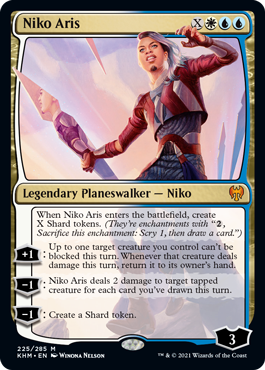
Let’s start with Niko Aris — the newest planeswalker to join the gang. Niko has a lot of flexibility when you can cast it, and I’ve heard a lot of players discussing the best value for X. I think the X should be thought of like gravy on top, and not a pivotal point in evaluating how good the card is; you can cast Niko for just three mana and get use out of it.
I think the other reason Niko isn’t getting much love is that it’s such a unique card, casting cost aside. The +1 ability requires you to have creatures that we want to connect with or recast, and it’s unclear how it’ll work with Niko’s other two abilities. The first -1 is a conditional removal ability that has other conditions built in, while the last ability is just a way to slowly generate card advantage.
To overcome the hurdle of the +1, I propose pairing Niko up with a card that opens the door to an entire archetype: Yorion, Sky Nomad. Yorion blinking multiple things is often an end game more controlling decks work towards, and Niko facilitates that plan well. You’re bound to find other creatures that are good targets for Yorion or Niko, but even just adding more copies of Yorion to your deck will provide more than enough value. Yorion decks are known for dragging games out, anyway, so this should help you put extra mana into casting Niko as well.
As Niko’s -1 abilities may seem underwhelming at first glance, you’ll be very happy to have them on this sort of card. The ability to clear up some early aggression is nice, as is simply having a card that gives you more uses for your mana on any given turn. These are not the primary reasons to play this card, but taken altogether, they make Niko a potentially potent Standard card.
Old-Growth Troll
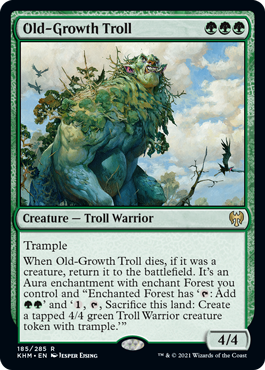
Niko isn’t the only card getting less love than it should from Standard players. Old-Growth Troll is a house of a creature, and one that deserves some time in the sun before the set drops.
Troll is not like your other statline creatures (looking at you, Yorvo) — it’s recursive in a way that few creatures of its size are. When the Troll dies, it turns in a ramping enchantment that you can use to cast more Trolls. That alone is a fairly strong case for this card: a big body with essentially flashback.
This card’s most obvious home is in Mono-Green Aggro, where I’m sure it’ll find a place. But I want to talk about another spot where I’m much more interested in this card: sideboards of green ramp decks.
The primarily-green ramp deck is one that we haven’t seen much recently; more often, we’ve seen green-based decks with multiple colors, like Temur in current Standard. There are a few good reasons for this: lack of good green payoffs and few ways to protect yourself while curving out. I think Troll does a fairly good job in this second role.
Bonecrusher Giant has helped keep aggressive decks in check by being both a removal spell and a well-costed creature. Troll serves a similar function — trading with or holding back multiple creatures when it comes down, while also serving as a form of ramp. This allows you to protect your life total as early as turn three while still working towards playing some of our big threats. Then, once you’re flush with mana, you get another body.
This dynamic of holding off or delaying the Gruul decks while still achieving your main plan is one that could propel a green-based ramp deck to success in Standard. Old-Growth Troll is an important piece of the puzzle; we’ll just have to wait and see if the rest fall into place.
Rise of the Dread Marn

Before we get into this card, I want to take a minute to talk about the foretell mechanic and its impact on play patterns. Quick refresher: Foretell allows you to pay two mana to exile a card in your hand facedown, and then you can cast it for its foretell cost. These cards give us some great opportunities to use all our mana every turn. Normally, a card like Rise of the Dread Marn would rot in your hand and force you to hold up three black mana to use it after an opponent’s board wipe or a big combat step. Foretell negates that drawback by allowing you to pay most of the mana for this card ahead of time. It’s still a cost, but it’s a serious upgrade over the alternative.
Another big thing to think about with foretell cards: the more playable foretell cards there are in a format, the better they all become. We saw this with morph when it was reintroduced a few years ago — even if your deck only had two different morph creatures, if they are both serious threats, it can be very challenging for your opponents. In Khans of Tarkir Standard, some Bant Company decks would play both Den Protector and Stratus Dancer to make opponents have to deduce what they might have. While this may not be reason enough to play a card, consider that the average foretell card gets ever so slightly stronger the more good ones your deck might be playing.
Rise of the Dread Marn is a very potent card at effectively “countering” board wipes. If your opponent tries to stabilize the board, they might just end up creating an equal-sized army. That’s the most obvious use of this card, but you could also play it in a sacrifice deck. Those decks will often sacrifice a lot of creatures in a turn, and they also tend to be weaker to board wipes. Currently, most of the best board wipes exile cards, but if that ends up changing, this card could make the sideboard of black aggressive decks.
While this isn’t a card you will most likely play four of in a deck, it seems like a strong contender for a spot or two in some main decks, with potential for sideboard play. The real interesting part of this card to me is its ability to be one of the more punishing foretell cards. If your deck wants to play a fair amount of foretell cards, having access to this could be a huge thorn in your opponent’s side.
Snakeskin Veil
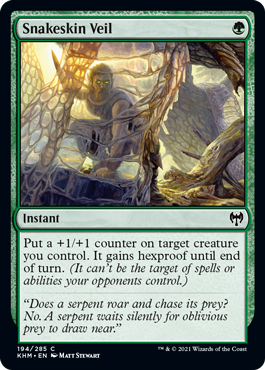
Pump spells get a bad rap and are often scoffed at for tournament play. They open you up to get two-for-one’d, and ask a lot of you for them to work. The rare occasion they do see play is when they are incredibly pushed, or when they double as a way to protect your creature.
Snakeskin Veil is the latter, allowing you for to save a creature and put a counter on it, all for just one mana. Veil is a marginal upgrade on Ranger’s Guile, but the upside is clear when you play it. Guile often reads as “Give target creature hexproof”; the temporary +1/+1 rarely matters. Veil allows you to give your creatures a permanent plus in power, and it scales into the late game.
The other big thing to note about this card is how well it works with cards that reward you for having counters. Conclave Mentor in Standard and Winding Constrictor in Historic are both cards that like having access to Ranger’s Guile as it is, but now they have a spell that synergizes with their strategy of adding additional counters. Standard actually has a few cards poised to make a move in the counters strategy, but funny enough, most of those are creatures. Cards like Luminarch Aspirant must be answered right away before they snowball.
These situational cards are often overlooked during preview season, but they can often lead substantial gains for an archetype. We tend to focus on splashy mythics and rares that we want to build around, but don’t overlook role players like this.
Vorinclex, Monstrous Raider
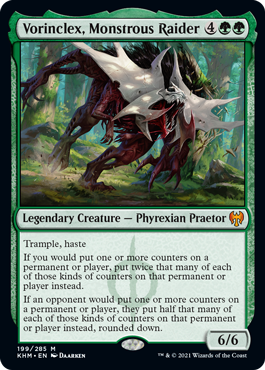
Vorinclex, Monstrous Raider is going to be a Standard role player for sure. This card was previewed at the start of the season, and it’s seen very little hype from players given how strong it is. As a 6/6 with both trample and haste, it will come down and instantly threaten the opponent, and it also doubles the counters you would put on a permanent or player. That means every planeswalker you play will most likely ultimate the turn you cast it — like Garruk, Unleashed, for example. But that’s not all: Vorinclex halves all counters your opponents would put on their permanents, so all the +1 abilities on your opponents’ planeswalkers won’t increase their loyalty.
This card has seen immense hype for Commander, and almost none for Standard. But when you start to think about all the things Vorinclex is capable of, it starts to get out of hand quickly.
Let’s start with the doubling ability. Obviously, all the planeswalkers you could combine this with will be quite strong, but it also means cards like The Great Henge will beef up your creatures even more. Cast this off a Great Henge, and it’ll come down as a 8/8 trampler with haste! Vorinclex will be the biggest thing on the board, and it will likely kill any ’walker your opponents had or break most board stalls.
Vorinclex also supports creatures that naturally gain counters. Wicked Wolf gains counters by eating food; add Vorinclex to the mix, and suddenly you’re representing a lot of burst damage from both Wicked Wolf and the hasty Vorinclex itself. Chainweb Aracnir normally escapes as a 4/5, but thanks to Vorinclex, it can be a 7/8! Both cards are key ingredients in the Mono-Green Food deck in Standard — now imagine what you can pull off by adding Vorinclex. Scary stuff!
There are also plenty of applications for Vorinclex’s counter-halving ability. Stopping planeswalkers from gaining loyalty is a huge upside — the longer a ’walker stays around, the harder they become to answer, and the more time and advantage they buy. But Vorinclex also just stops all your opponents’ sagas. Since sagas’ abilities don’t trigger until counters are added, they simply won’t function with Vorinclex around. Most sagas have very impactful third chapters, like Elspeth Conquers Death, but thanks to Vorinclex, they wont get their full value from the card. With more sagas coming in Kaldheim and a handful currently seeing play in Standard, Vorinclex is poised to tear up the Standard metagame.
Which cards from Kaldheim are you most excited for so far? Are there any cards that you think have been overlooked during preview season? Tweet at @masoneclark and @card_kingdom and let us know!

Mason Clark is a grinder in every corner of the game who has played at the pro level and on the SCG Tour with Team Nova. Whether he’s competing in Standard, Historic or Modern, Mason plays with one goal in mind: to be a better player than he was the day before. Check out his podcast, Constructed Criticism, and catch his streams on Twitch.

